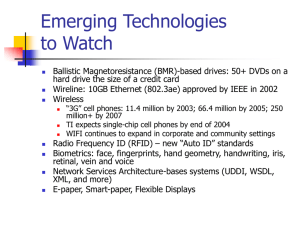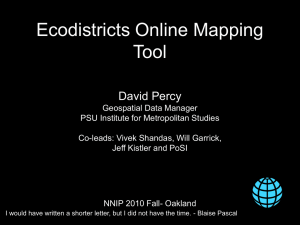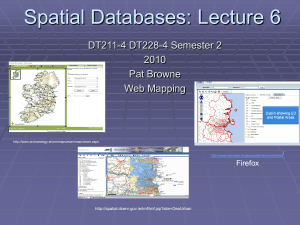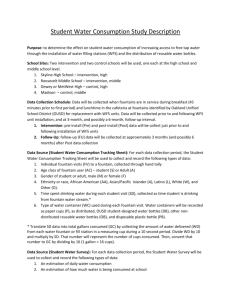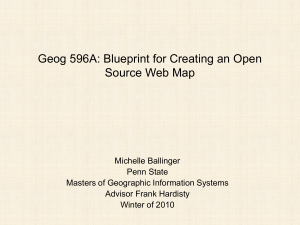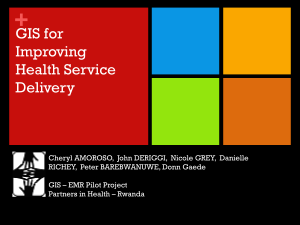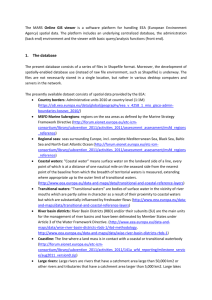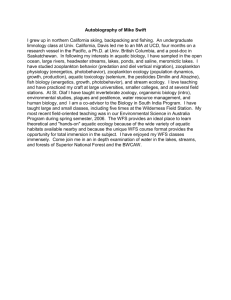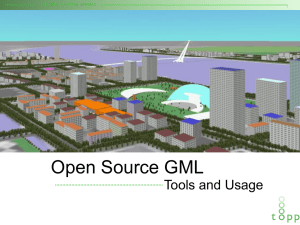Using PostgreSQL and PostGIS as a Spatial Da
advertisement
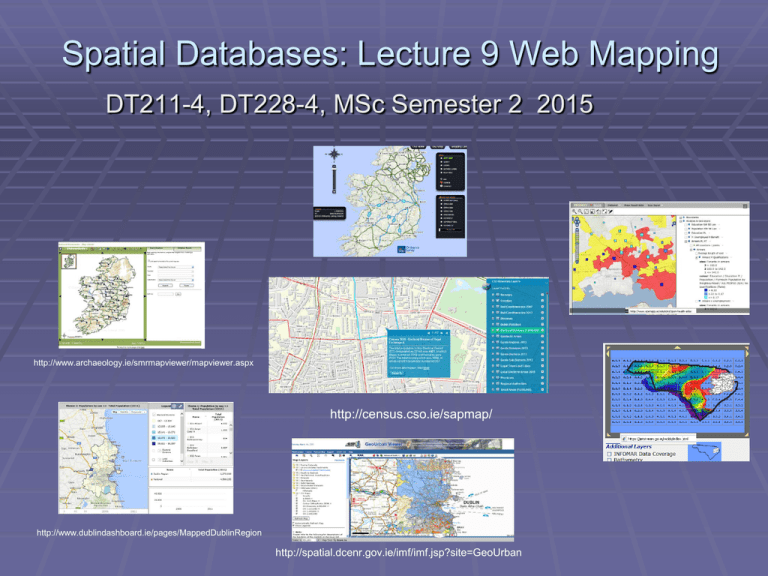
Spatial Databases: Lecture 9 Web Mapping
DT211-4, DT228-4, MSc Semester 2 2015
http://maps.osi.ie/publicviewer/#V1,588882,739883,0,10
http://www.archaeology.ie/smrmapviewer/mapviewer.aspx
http://census.cso.ie/sapmap/
http://www.dublindashboard.ie/pages/MappedDublinRegion
http://spatial.dcenr.gov.ie/imf/imf.jsp?site=GeoUrban
W3C and location
Location and geographical properties of resources has
always been something of a dilemma for the World Wide
Web, which has served so well to unlink the global
identity of a resource from its physical location on the
globe. One of the Web's greatest values is its capacity
for enabling the growth of communities which are not
constrained by distance and geography. Nonetheless,
physical location is at least an essential property if not a
part of the identity of any real entity. When appropriate,
the Local Web of resources identified by location and
geography is an essential aspect of Web discovery and
communication.
Joshua Lieberman, Geospatial Incubator Group Chair,
2007/10/3, http://www.w3.org/2005/Incubator/geo/
Spatial Databases must integrate
with other applications and data.
HTML Viewer
Java Viewer
(Internet)
GIS Desktop
Applications
Wireless
Mobile
Devices
Network
Custom
Applications
Map Renderer
Spatial
DB
Server Side
Applications
Outline
Question: What need to be done to allow geographic
data to be available on the Web?
Answer: A lot!
The a typical Open Geo-Stack:
PostGIS for persistence: We need some structured way to hold
spatial & non-spatial data.
Geoserver for server side map specific function WMS,WFS.
OpenLayers for client side programming to handle user interaction.
A web service (WS) is a software system designed to
support interoperable machine-to-machine interaction
over a network (W3C). A WS is any service that is
available over the Internet, uses a standardized XML
messaging system, and isn't tied to any one operating
system or programming language.
Typical web mapping
configuration
Web Services
The W3C defines a Web service as a software
system designed to support interoperable
machine-to-machine interaction over a network.
It has an interface described in a machineprocessable format (specifically WSDL). Other
systems interact with the Web service in a
manner prescribed by its description using
SOAP messages, typically conveyed using
HTTP with an XML serialization in conjunction
with other Web-related standards.
Web services for mapping
The principle OGC web services are;
WMS; standardizes the display of map images. WMS
can register and overlay maps from multiple remote
sources.
WFS-T: standardizes the retrieval and update of
features.
WPS: can describe calculations or processes (inputs and
outputs, triggers, execution) as a Web Service. The
processes can be supplied by a GIS (e.g. GRASS or
special API)
WCS: standardizes access to spatially extended
coverages, usually encoded in a binary format and
offered by a server (typically remotely sensed data).
Web services for mapping
Web services have reached a level of
sophistication that facilitates the delivery
and use of spatial information. Web
services for mapping enable sharing
information.
Web services for mapping allow
consumers and providers of information to
integrate diverse data sets.
Web services for mapping
To access remote data we need specific
knowledge about that data source: server
address, data layers available, meta-data,
required and available data format.
Once the system knows the details, application
can request exactly maps and other information
We will GeoServer as our map server.
Another popular open source map server is
simply called MapServer (http://mapserver.org/)
Web services for mapping
The course web site list many examples of
data sharing. Many of the links show how
government departments share data with
the public and other departments. Which
means data users don't need to store their
data locally. In many cases centralizing
data storage can lead to cost savings and
avoid redundancy. Web services for
mapping can facilitate integration,
centralization and sharing.
OGC Web Map Service (WMS)
The OpenGIS® Web Map Service Interface Standard
(WMS) provides a simple HTTP interface for requesting
geo-registered map images from one or more distributed
geospatial databases. A WMS request defines the
geographic layer(s) and area of interest to be processed.
The response to the request is one or more georegistered map images (returned as JPEG, PNG, etc)
that can be displayed in a browser application. The
interface also supports the ability to specify whether the
returned images should be transparent which allows
layers from multiple servers can be combined.
OGS’s features
Feature associated with a location relative to the Earth.
The starting point for modeling of geographic
information. A feature is an abstraction of a real world
phenomenon. A geographic feature is a feature
associated with a location relative to the Earth. A digital
representation of the real world can be thought of as a
set of features.
Geographic features occur at two levels: feature
instances and feature types. At the instance level, a
geographic feature is represented as a discrete
phenomenon that is associated with its geographic and
temporal coordinates. These individual feature instances
are grouped into classes with common characteristics feature types.
OGC WFS
The OGS Web Feature Service Interface Standard (WFS) defines
an interface for specifying requests for retrieving geographic
features across the Web using platform-independent calls. The WFS
standard defines interfaces and operations for data access and
manipulation on a set of geographic features, including:
Get or Query features based on spatial and non-spatial constraints
Create a new feature instance
Get a description of the properties of features
Delete a feature instance (WFS-T)
Update a feature instance (WFS-T)
Lock a feature instance (WFS-T)
By default, the specified feature encoding for input and output is the
Geography Markup Language (GML) which in turn is written in XML.
OGC WFS
Via the WFS interfaces, a web user or service
can combine, use and manage features from
different sources by invoking the following WFS
operations on geographic features and
elements:
Create a new feature instance
Delete a feature instance
Update a feature instance
Lock a feature instance
Get or query features based on spatial and nonspatial constraints
OGC WFS
Web Services Description
Language is an XML
format for describing
network services as a set
of endpoints operating on
messages containing
either document-oriented
or procedure-oriented
information.
WFS follows the web services model
OGC WFS
Basic sequence of events
WFS 1.1.0
The following is a description of the Web
Feature Service 1.1.0 specification from
the Open Geospatial Consortium (OGC).
WFS-T is well suited to applications were
a user needs to interact with the map data
(e.g. select objects, query objects and
update objects). We cover:
a basic description,
the main operations,
the basic processing sequence for a simple
request.
Basic description of WFS 1.1.0
The Web Feature Service (WFS) is an interface
specified by the OGC that allows for the exchange of
geographic data across the Web. It defines the rules for
requesting and retrieving geographic information using
the Hyper Text Transmission Protocol (HTTP). The
interface describes the data manipulation operations on
geographic features. Extensible Markup Language
(XML) -based Geographic Markup Language (GML) is
used for exchange of information. WFS-T supports the
vector data model.
Main Operations of WFS 1.1.0
A WFS implementation allows a client to retrieve and
update features encoded in GML from multiple servers.
The WFS operations support INSERT, UPDATE,
DELETE, LOCK, QUERY and DISCOVERY operations.
A g eographic feature is described by a set of properties
where each property can be thought of as a {name, type,
value} tuple. The name and type of each feature property
is determined by its type definition. Geographic features
are those that may have at least one property that is
geometry-valued.
See notes below for further detail
Basic processing sequence for
WFS 1.1.0
Additional features of WFS 2.0
Supports temporal queries, versioning, stored queries, joins, and spatial joins
Real time flight dispatch scenarios (disruption due to volcanic ash and snow) use WFS 2.0 to
retrieve and update data in real-time via web services (WFS and eventing).
Web Feature Service 2.0 used for INSPIRE Compliance. Allows the distribution of data via the
latest web service standard.
Integrated data validation - preview and fix XML/GML
Temporal queries can improve decision making
WFS 2.0 used for INSPIRE data publishing.
Discovery operations allow the service to be interrogated to determine its capabilities and to
retrieve the application schema that defines the feature types that the service offers.
Query operations allow features or values of feature properties to be retrieved from the underlying
data store based upon constraints, defined by the client, on feature properties.
Locking operations allow exclusive access to features for the purpose of modifying or deleting
features.
Transaction operations allow features to be created, changed, replaced and deleted from the
underlying data store.
Stored query operations allow clients to create, drop, list and described parameterized query
expressions that are stored by the server and can be repeatedly invoked using different parameter
values.
Web services for mapping
Data can be shared in a number of ways. A
complete copy can be given to the remote user
allowing them to use the data for any purpose.
Alternatively, a more limited form of access can
be granted. For example, users of Google Map
do not get the actual spatial data although they
are granted a high degree of usage through the
Google Map API. OGC WMS (see later)
provide to bitmap image rather than the vector
map itself, whereas WFS provides vectors.
Web services for mapping
Some spatial data, such as hurricane
locations, is constantly changing
(streamed). It does not make sense to
download such data. It would be better to
integrate the weather layer in your map
that accesses a web service in realtime.
Web services can make very large data
sets available to users, reducing the need
for continual data storage upgrades.
Requesting a Map
GeoServer can request map data from a remote web server
Typical web map services software
environment
OpenLayers is a JavaScript library for
displaying map data in a web browser.
We will look at OpenLayers later
ModJK is the connector used to
connect Tomcat servlet container with
web servers such as Apache. We use
GeoServers servlet container called
Jetty and do not need to connect to
Apache.
GEOS (Geometry Engine, Open
Source) is a library used by
PostGIS to perform all the
operations in the OpenGIS
Simple Features for SQL
Specification.
PROJ.4 is an open source library
used by PostgIS to convert
between geographic coordinate
systems
The OGC Web Service package
Client and WFS messages
A Typical Web Page Layout
GeoServer’s architecture
ArcSDE technology manages spatial
data in a relational database
management system (RDBMS) and
enables it to be accessed by ArcGIS
clients. It is the technology that
provides the framework to support
long transactions, which facilitates the
versioned editing environment in
multiuser geodatabases.
MapInfo Interchange
Format (MIF) is a map
and database exporting
file format of MapInfo
software product.
The JTS
Topology Suite is
an API of 2D
spatial
predicates and
functions.
GeoServer
GeoServer can access and provide data using a
web services framework.
The Open Geospatial Consortium (OGC) has
developed specifications for web services for
mapping. The OGC aim to increase
interoperability between applications by creating
common interchange languages through
common standards. GeoServer implements
OGC’s web mapping services.
GeoServer & OGC specifications
Web Map Service (WMS) Share and request vector and raster map
data in plain image format
Web Feature Service (WFS) Share and request vector map data
and attributes in GML format
Web Feature Service –Transactional (WFS-T ) is a WFS that
supports transactions - add, delete, or update features.
Web Coverage Service (WCS) Share image/raster data with original
data value
Web Map Context (WMC) Save and load views of a WMS
application as XML
Styled Layer Descriptors (SLD) Request particular symbolization
and styling from a WMS
Geography Markup Language (GML) XML-based format for spatial
and tabular data interchange
Filter: Encoding XML-based format for defining queries on spatial
data
GeoServer & OGC specifications
GeoServer 1.6.0 and above supports WFS 1.1
WFS 1.1 supports on the fly re-projection of data, which
means data can be returned in a SRS other than the
native one. We can check the WFS version as follows:
http://localhost:8080/geoserver/wfs?request=GetCapabilities&service=WFS&version=1.0.0
Here is the XML for the reference system
<SRS>EPSG:4326</SRS>
Required WMS parameters for a
GetMap request
Serving static files within
Geoserver
On Geoserve static web files are stored in
the www subfolder of the GeoServer data
directory, and they are served at
http:/myhost:8080/geoserver/www.
In the www folder you can store html,
images and Javascript and have
Geoserver provide them on the web with
AJAX callbacks.
Using Servlets with GeoServer
Geoserver uses Jetty as a servlet container.
Jetty is an open-source embeddable web server
and servlet container, written in Java.
http://www.mortbay.org/jetty/
Jetty can handle Java servlets and
JavaServerPages (JSP) technologies and
traditional static web pages.
There is a Jetty Servlet tutorial at:
http://www.seas.upenn.edu/~cis550/jetty.html
Using Servlets with GeoServer
Each GeoServer service is provided by a
specific Servlet that intercepts the client
requests and builds up the response in
accordance to the GeoServer
configuration.
Geoserver can be deployed as a standard
WAR package inside Java Servlet
containers.
Configuration Interface
Managing a Geographic Database
From Mobile Devices Through
OGC Web Services
The OGS’s Spatial Web
Universal Description,
Discovery and
Integration (UDDI) is a
platform-independent,
XML-based registry for
businesses worldwide to
list themselves on the
Internet.
The OGS’s Spatial Web
Web Feature Service
•A WFS must implement the following operations:
•GetCapabilities - queries the WFS service to determine
available options.
•DescribeFeatureType - retrieves the XML schema to
allow the WFS client to parse the result sets.
•GetFeature - performs the actual query - parameters such
as bounding box and any other filters should be passed in, as
appropriate, and the WFS service then returns a GML result
set containing full geometry and feature attributes.
OpenLayers
OpenLayers
OpenLayers
OpenLayers (OL) is an open source JavaScript library
for displaying map data in web browsers. OL provides an
API for building complex web-based geographic
applications. Data can be combined from a number of
sources without requiring any server side processing as
layers can be assembled and rendered on the client.
Client side programming includes panning and zooming
of maps, client-side tiling, markers, popup windows,
various adjustable navigation components, keyboard
commands, an event handling mechanism and client
server communications. Each part of OL is configurable.
OL can act as a Web Client for Geoserver.
See; http://www.bostongis.com/?content_name=openlayers_tut_01
OpenLayers
<html>
<head>
<script type='text/javascript'>
function drawOnCanvas() {
var canvas = document.getElementById('example');
var context = canvas.getContext('2d');
context.fillStyle = 'red';
context.fillRect(10, 10, 50, 50);
}
</script>
</head>
<body onload='drawOnCanvas()'>
<canvas id='example' width='512' height='256'>
</canvas>
</body>
</html>
See : http://localhost:8080/geoserver/www/box/html
http://147.252.234.32:8080/geoserver/www/box.html
SQL OpenLayers
get: function(key) {
var name = this.name;
this.db.transaction(
function(tx) {
console.log("Select value from OLTable where key=?");
tx.executeSql("Select value from OLTable where key=?", [key],
function(tx, result) { if(result.rows.length)
{ return result.rows.item(0).data;1 } },
function(tx, error) { console.debug(error); }); }); }
OpenLayers
OL can act as a Web Client for:
1. OGC web services (WFS-T,WMS, and WCS
(XML.GML)),
2. Commercial services such as Google Maps(KML),
MSN Virtual Earth, ESRI products
3. Cpen source initiatives or defacto standards such as
Geographically Encoded Objects for RSS feeds
(GeoRSS). The OL GeoRSS parser will
automatically connect an information bubble to the
map markers, similar to Google maps.
OpenLayers
OL helps integrates a diverse set of heterogeneous data sources
(e.g. shape file and database). A variation on OL is Mapbulider
built into GeoServer which supports OGC WFS and WMS.
OL facilitates a client-side JavaScript "map -mash-up” style
application; A mash-up is a Web application that combines data
from one or more sources into a single integrated tool. The term
Mashup implies easy, fast integration, frequently done by access
to open APIs and data sources to produce results that were not
the original reason for producing the raw source data. An example
of a mashup is the use of cartographic data from Google Maps to
add location information to real estate data, thereby creating a new
and distinct Web service that was not originally provided by either
source.
OpenLayers
OL can return projection information. A
projection is a way of converting geographic
coordinates (latitude and longitude) into a
plane (Irish National Grid).
OL supports any projection, but needs PROJ4
for OL for projections on the fly. OL can request
form map servers data in a particular
projection. Strong support for the Spherical
Mercator projection used by Google Map, Open
Street Map, and Virtual Earth.
OpenLayers
Two ways of getting data.
In one mode OL can request new data without
refreshing an entire document, requests can be
made to any origin. Another way to retrieve
data from a server is to update the location of a
document in a frame. These types of requests
can also be made to any origin. However, the
code running in the original document is
restricted to reading data in documents that
come from the same origin.
OpenLayers uses AJAX
Underlying technology
The basic technology is Asynchronous JavaScript and XML
(AJAX) which includes of JavaScript and XML. XML is the W3C
recommended standard for creating formats and sharing data on the
Web
OL normally uses XML for data interchange (though JavaScript
Object Notation (JSON) can be used as an alternative). Ajax is a
way of developing Web applications that combines:
XHTML and CSS standards based presentation
Interaction with the page through the DOM
Data interchange with XML and XSLT
Asynchronous data retrieval with a XMLHttpRequest object which is
used to read or send data on the server asynchronously.
JavaScript to tie it all together
OpenLayers uses AJAX
The Ajax interpreter works within the Web browser
(through JavaScript and the DOM) to render the Web
application and handle any requests that the user might
have of the Web server. Because the Ajax runtime is
handling the requests, it can hold much of the
information in the Ajax environment, while allowing the
interaction with the application and the customer to
happen asynchronously and independently of any
interaction with the server. This allows the browser to
handle a lot of the map processing locally without
reference to the server e.g. display, rendering, scaling,
querying.
OpenLayers uses AJAX
Asynchronous data transfers through the XMLHttpRequest object.
This allows websites to be refreshed in the background instead of
having to be re-loaded after every modification. Because of this
technology, a web mapping application is able to execute a user’s
command in a fairly short time period, as the necessary steps can
be completed in the background. As a result, the usability of
interactive web mapping applications is approaching the features of
classic Desktop (GIS) applications. The processing of web page
formerly was only server-side, using web services or PHP scripts,
before the whole page was sent within the network. But Ajax can
selectively modify a part of a page displayed by the browser, and
update it without the need to reload the whole document with all
images, menus, etc... For example, fields of forms, choices of user,
may be processed and the result displayed immediately into the
same page.
OpenLayers Security
Browsers execute JavaScript code in a sandbox, a
sealed environment with little or no access to the
computer’s resources. In general OL uses AJAX security
features. All communication initiated by OpenLayers.
Request methods are restricted to the same origin
policy: requests may only be issued with the same
protocol, to the same domain, and through the same port
as the document the code is running from. This is
because of the underlying JavaScript security model.
JavaScript programs have control over their own page
inside the browser, but that is where their abilities end.
The underlying AJAX security can limit interaction; this
can be circumvented using proxy server.
Example of OL usage
<html>
<head>
<script src = "http://www.openlayers.org/api/OpenLayers.js"></script>
<script type = "text/javascript">
function test_Map_Zoom(t)
t.plan(1);
var map = new OpenLayers.Map("map");
var layer = new OpenLayers.Layer.WMS("ABC",
"http://example.com/123",
'layers':'test');
map.addLayer(layer);
map.zoomTo(0);
t.eq(map.zoom, 0, "Map zoomed to level 0 correctly.");
</script>
</head>
<body>
<div id="map" style="width: 512px; height: 512px;"/>
</body>
</html>
Example of OL layers
Osmarender is a rule-based rendering tool for generating SVG images of OSM data. It
takes as its input an OpenStreetMap dataset and a rules file. It outputs an SVG image
that is marked up in accordance with the styles defined in the rule file.
Mapnik is the Open Source map renderer which we use to render the main Slippy Map
layer for OSM. The slippy map is an AJAX component. JavaScript runs in the browser,
which dynamically requests tiles from the server in the background (without reloading the
whole HTML page) to give a smooth slippy zoomy map browsing experience. The
implementation of this is mostly provided by OpenLayers.
CycleMap contains cycling specific information, lanes, routes, networks.Cycle routes are
named or numbered or otherwise signed routes, which may go along roads or dedicated
cycle paths.
Example of OL code
var DITKevinStreetLat=53.338
var DITKevinStreetLon=-6.268
var zoom=16
var map2;
function init() {
map2 = new OpenLayers.Map ("map2", {
controls:[
new OpenLayers.Control.Navigation(),
new OpenLayers.Control.PanZoomBar(),
new OpenLayers.Control.LayerSwitcher(),
maxExtent: new OpenLayers.Bounds(-20037508.34,-0037508.34,
20037508.34,20037508.34),
maxResolution: 156543.0399,
numZoomLevels: 19,
units: 'm',
projection: new OpenLayers.Projection("EPSG:900913"),
displayProjection: new OpenLayers.Projection("EPSG:4326")} );
layerMapnik = new OpenLayers.Layer.OSM.Mapnik("Mapnik");
map2.addLayer(layerMapnik);
layerCycleMap = new OpenLayers.Layer.OSM.CycleMap("CycleMap");
map2.addLayer(layerCycleMap);
var lonLat =
new OpenLayers.LonLat(DITKevinStreetL, DITKevinStreetL).transform(new
OpenLayers.Projection("EPSG:4326"), map2.getProjectionObject());
map2.setCenter (lonLat, zoom); }
OpenLayers Core Classes
OpenLayers.Map: is the main class of the OpenLayers API. It
compiles the application's main map and provides numerous
methods for the administration of the map display, including the
display of layers and operating components, zooming and
panning. In addition, this class allows for queries of current map
status through numerous 'get' methods.
OpenLayers.Layer: All map displays are based on the Layer
class. Layer.js produces individual layers, sets the transparency
and resolution of each, and provides the basic 'get' methods.
OpenLayers.Control: Operating elements in OpenLayers are
elements related to map navigation as well the display of map
information (e.g. scale). The Control class serves as a base class
for all operating elements, among them:Ajax avoids the traditional
Web client/server/web-page interaction between the customer and
the server.
OpenLayers Core Classes
OpenLayers.Events: takes over the event handling from
OpenLayers.
OpenLayers.Pixel: displays monitor coordinates in n x- and y- pixel
values.
OpenLayers.Size: displays a pixel size value pair in width and
height.
OpenLayers.LonLat: displays geographic coordinates in longitude
and latitude.
OpenLayers.Bounds: displays a rectangular area (bounding box)
whose four sides (left, below, right, above) are indicated with
geographic coordinates in float format. The Bounds class provides
different get-functions (e.g. center and pixel dimensions of the
bounding box) as well as comparative functions (e.g. whether a
pixel is located within the defined bounding box).
OpenLayers.Util: contains the different functions and settings
which cannot be assigned to any of the other OpenLayers classes.
OpenLayers Core Classes
OpenLayers.Events: takes over the event handling from
OpenLayers.
OpenLayers.Pixel: displays monitor coordinates in n x- and y- pixel
values.
OpenLayers.Size: displays a pixel size value pair in width and
height.
OpenLayers.LonLat: displays geographic coordinates in longitude
and latitude.
OpenLayers.Bounds: displays a rectangular area (bounding box)
whose four sides (left, below, right, above) are indicated with
geographic coordinates in float format. The Bounds class provides
different get-functions (e.g. center and pixel dimensions of the
bounding box) as well as comparative functions (e.g. whether a
pixel is located within the defined bounding box).
OpenLayers.Util: contains the different functions and settings
which cannot be assigned to any of the other OpenLayers classes.
Mapbuilder
Mapbuilder is a client-side Javascript library for
putting mapping in a web page, using an AJAX
style of interaction. It works by retrieving XML
data from the various sources and rendering that
using the browser's built in XSL processor, so
the initial HTML page never has to reload.
Server-side requirements are minimal: at
minimum an HTTP server, at most 2 other
server scripts which are provided (for PHP and
J2EE environments).
Web Map Context File
<ViewContext>
<General>
<Window width="500" height="285" />
<BoundingBox SRS="EPSG:4326"
minx="-179.14734"
miny="17.884813"
maxx="179.77847000000006"
maxy="71.35256064399981" />
<Title>g4wd:st99_d00 Map</Title>
<KeywordList>
<Keyword>g4wd:st99_d00</Keyword>
</KeywordList>
<Abstract></Abstract>
</General>
<LayerList>
<Layer queryable="1" hidden="0" >
<Server service="OGC:WMS" version="1.1.1"
title="g4wd:st99_d00 Preview" >
<OnlineResource xlink:type="simple" xlink:href="../wms" />
</Server>
<Name>g4wd:st99_d00</Name>
<Title>g4wd:st99_d00</Title>
<SRS>EPSG:4326</SRS>
<FormatList><Format current="1" >image/png</Format></FormatList>
</Layer>
</LayerList>
</ViewContext>
Web Map Context File
The OGC Web Map Context File
The Context file defines the viewable
Non-spatial attributes of the map such as
the size and the title. It also identifies the
data layers that should be included on the
map.
Web Map Context File
The Context file is an OGC standard that
can be shared across server
implementations. Write this file once, and
it is reusable from one server to the next.
The newer OWS Context documents
support WFS and WCS layers as well as
WMS layers.
Web Map Context
OGS Web Map Context (WMC) Implementation
Specification is a companion to the OGC Web
Map Service, it describes how to save a map
view comprised of many different layers from
different Web Map Servers. A 'context' can be
encoded and saved so that Web maps created
by users can be automatically reconstructed and
augmented by the authoring user or other users
in the future. A Context document is structured
using eXtensible Markup Language (XML).
OGC Web Services (OWS) Context
Document
Visualization
Application
or Tool A
Visualization
Application
or Tool B
Context
Shareable content,
session, area of
interest
WMS
WMS
WMS
WMS
WPS
A WPS can be configured to offer any sort of GIS functionality to
clients across a network, including access to pre-programmed
calculations and/or computation models that operate on spatially
referenced data. A WPS may offer calculations as simple as
subtracting one set of spatially referenced numbers from another
(e.g., determining the difference in influenza cases between two
different seasons), or as complicated as a global climate change
model. The data required by the WPS can be delivered across a
network, or available at the server.
This interface specification provides mechanisms to identify the
spatially-referenced data required by the calculation, initiate the
calculation, and manage the output from the calculation so that it
can be accessed by the client. This Web Processing Service is
targeted at processing both vector and raster data.
WPS
WPS
http://dev.bnhelp.cz/inspire/client/
Openlayers
Openlayers
Geoserver
OWS
WMS WFS
WMS WFS
Openlayers
Many formats for Layers
OGC WFS
GeoRSS
CSV
GML
KML
WKT
Vector
Layers,
points,
lines,
polygons
rendered
with SVG
/ VML
OGC WMS
Google Maps
MSN Live
Local
Yahoo! Maps
Multimap
ka-Map
WorldWind
Raster
Layers,
tiled
WPS Operations
GetCapabilities – This operation allows a client to request and
receive back service metadata (or Capabilities) documents that
describe the abilities of the specific server implementation. The
GetCapabilities operation provides the names and general
descriptions of each of the processes offered by a WPS instance.
This operation also supports negotiation of the specification version
being used for client-server interactions.
DescribeProcess – This operation allows a client to request and
receive back detailed information about the processes that can be
run on the service instance, including the inputs required, their
allowable formats, and the outputs that can be produced.
Execute – This operation allows a client to run a specified process
implemented by the WPS, using provided input parameter values
and returning the outputs produced.
WPS Example
Consider the case of a process that can intersect two polygons. The
response to a GetCapabilities request might indicate that the WPS
supports an operation called ―intersect, and that this operation is
limited to intersecting one polygon with a second polygon. The
response to a DescribeProcess request for the ―intersect process
might indicate that it requires two inputs, namely: ―FirstPolygon
and ―SecondPolygon, and that these inputs must be provided in
GML 2.2. Furthermore, the process will produce one output, in either
GML 2.2, or GML 3.1, and it can be delivered as a web-accessible
resource.
WPS Example (continued)
The client would run the process by calling the Execute operation,
and might choose to provide the two input polygons embedded
directly within the request, and identify that the output should be
stored as a web-accessible resource. After completion, the process
would return an ExecuteResponse XML document that identifies the
inputs and outputs, indicates whether or not the process executed
successfully, and if successful, contains a reference to the webaccessible resource.
WPS Interaction Diagram
What WPS does
Describes the service interface, it specifies a
request/response interface that defines how to:
encode requests for process execution
encode responses from process execution
embed data and metadata in process execution
inputs/outputs
reference web-accessible data inputs/outputs
support long-running processes
return process status information
return processing errors
request storage of process outputs
WFS-T
The Web Feature Service (WFS) is an interface
specified by the OGC that allows for the exchange of
geographic data across the Web.
It defines the rules for requesting and retrieving
geographic information using the Hyper Text
Transmission Protocol (HTTP).
The interface describes the data manipulation operations
on geographic features.
Extensible Markup Language (XML) -based Geographic
Markup Language (GML) is used for exchange of
information.
WFS-T supports the vector data model.
WFS-T
A WFS implementation allows a client to retrieve and update features encoded in GML from
multiple servers.
The WFS operations support INSERT, UPDATE, DELETE, LOCK, QUERY and DISCOVERY
operations.
A geographic feature is described by a set of properties where each property can be thought of as
a {name, type, value} tuple.
The name and type of each feature property is determined by its type definition.
Geographic features are those that may have at least one property that is geometry-valued.
A WFS a transaction is a logical unit of work that is composed of one or more data manipulation
operations.
Though not directly addressed by WFS, WFS assumes that geographic features are persistently
stored and that transaction semantics, such as atomic failure,
are assumed to exist. It is the function of a web feature service, in its interaction with the data
storage system used to persistently store features,
to ensure that changes to data are consistent. (e.g. shape files or relational database systems
based on SQL).
Typical WFS transaction simple request
WFS-T
Typical WFS transaction simple request
WFS-T
The WFS specification details all the required XML and
GML definitions, of meta data and map data,
predicate or filter language will be defined in XML and be
derived from CQL(like SQL where) as defined in
the OpenGIS Catalogue Interface Implementation
Specification.
The following diagram shows the basic WFS client
server model (WFS follows a general web service model
).
WFS-T is well suited to applications were user needs to
interact with the map data (e.g. select objects, query
objects and update objects).
WFS-T 2.0
WFS-T 2.0 upports temporal queries, versioning, stored
queries, joins, and spatial joins
Real time flight dispatch scenarios (disruption due to
volcanic ash and snow) use WFS 2.0 to retrieve and
update data in real-time via web services (WFS and
eventing).
Web Feature Service 2.0 used for INSPIRE
Compliance. Allows the distribution of data via the latest
web service standard.
Integrated data validation - preview and fix XML/GML
Temporal queries can improve decision making
WFS 2.0 used for INSPIRE data publishing.
WFS-T 2.0
Discovery operations allow the service to be interrogated to
determine its capabilities and
to retrieve the application schema that defines the feature types that
the service offers.
Query operations allow features or values of feature properties to be
retrieved from the underlying data store based upon constraints,
defined by the client, on feature properties.
Locking operations allow exclusive access to features for the
purpose of modifying or deleting features.
Transaction operations allow features to be created, changed,
replaced and deleted from the underlying data store.
Stored query operations allow clients to create, drop, list and
described parametrized query expressions that are stored by the
server and can be repeatedly invoked using different parameter
values.
PL/pgSQL
PL/pgSQL is a loadable procedural language for the PostgreSQL database
system. The design goals of PL/pgSQL were to create a loadable
procedural language that
can be used to create functions and trigger procedures,
adds control structures to the SQL language,
can perform complex computations,
inherits all user-defined types, functions, and operators,
can be defined to be trusted by the server,
a method of creating stored procedures or SQL-procedures
Functions created with PL/pgSQL can be used anywhere that built-in
functions could be used. For example, it is possible to create complex
conditional computation functions and later use them to define operators or
use them in index expressions.
Advantages of Using
PL/pgSQL
SQL is the language PostgreSQL and most other
relational databases use as query language. It's portable
and easy to learn. But every SQL statement must be
executed individually by the database server.
That means that your client application must send each
query to the database server, wait for it to be processed,
receive and process the results, do some computation,
then send further queries to the server. All this incurs
interprocess communication and will also incur network
overhead if your client is on a different machine than the
database server.
Advantages of Using
PL/pgSQL
With PL/pgSQL you can group a block of computation and a series
of queries inside the database server, thus having the power of a
procedural language and the ease of use of SQL, but with
considerable savings of client/server communication overhead.
Extra round trips between client and server are eliminated
Intermediate results that the client does not need do not have to be
marshalled or transferred between server and client
Multiple rounds of query parsing can be avoided
This can result in a considerable performance increase as
compared to an application that does not use stored functions.
Also, with PL/pgSQL you can use all the data types, operators and
functions of SQL.
PL/pgSQL Function
This function returns the Fibonacci number for a position in the Fibonacci
sequence. You must be in the postgis database for this definition to work.
CREATE OR REPLACE FUNCTION fib ( fib_for integer )
RETURNS integer AS $$
BEGIN
IF fib_for < 2 THEN
RETURN fib_for;
END IF;
RETURN fib(fib_for - 2) + fib(fib_for - 1);
END;
$$ LANGUAGE plpgsql;
Call the function in the SQL shell
select fib(8);
PL/SQL
Triggers and stored procedures
PostgreSQL can used triggers to execute
a stored procedure when certain actions
are taken, like an INSERT, DELETE, or
UPDATE in a table. Or a procedure may
be executed on a regular basis, perhaps
once a day.
Triggers and stored procedures
Execute the function check_account_update
whenever a row of the table accounts is about to be
updated, only if column balance is specified as a target
in the UPDATE command:
CREATE TRIGGER check_update
BEFORE UPDATE OF balance ON accounts
FOR EACH ROW
EXECUTE PROCEDURE
check_account_update();
Why Use Stored Procedures
and Triggers?
Provide central validation
Track changes
Enhance security
Defer deletions
Find Road segment near a point
Here is a PL/pgSQL function that finds a
road segment that is closest to a given
point P as shown. The query returns the
source attribute.
Create a line
The following PL/pgSQL function makes a line
CREATE FUNCTION make_line() RETURNS GEOMETRY AS $$
BEGIN
RETURN ST_LineFromMultiPoint(
st_collect(ARRAY['POINT(10 10)',
'POINT(20 30)',
'POINT(20 60)',
'POINT(100 100)'])); END;
$$ LANGUAGE plpgsql;
Find the midpoint of a line
Given the previous make_line here is the SQL that finds the mid
point.
SELECT ST_AsText(Line_Interpolate_Point(make_line(), 0.5));
The function returns a point interpolated along a line. The second
argument is a float8 between 0 and 1 representing fraction of total
length of linestring the point has to be located. Linear Interpolation.
(LI) is a piecewise linear function (piece = line segment) applied
between two know (or measured) adjacent points. It is assumed that
all intermediate points between the know points satisfy the equation
of that line. This interpretation is important because it influences the
definitions of spatial operations that use line e.g. the union of two
regions. This usage of the term is employed by the OGC in relation
to line representation
Voronoi diagrams & Delaunay triangulation
A set of points S in the plane can be considered as Voronoi sites. Each
site s has a Voronoi cell V(s) consisting of all points closer to s than to any
other site. The segments of the Voronoi diagram are all the points in the
plane that are equidistant to two sites. The Voronoi nodes are the points
equidistant to three (or more) sites. The Voronoi diagram of a set of sites
partitions space into regions one per site the region for a site S consists of
The Voronoi diagram problem
Given a set of n points, the Voronoi diagram
consists of all the Voronoi polygons of these
points.
E.g. A Voronoi diagram of 6 points:
The vertices of the Voronoi diagram are
108
called Voronoi points and its segments are
called Voronoi edges.
Summary of Voronoi
Properties
A point q lies on a Voronoi edge between sites p
and pj iff the largest empty circle centered at q
touches only pi and pj
A Voronoi edge is a subset of locus of points
equidistant from pi and pj
pi : site points
pi
e : Voronoi edge
v : Voronoi vertex
q
pj
v
e
i
Summary of Voronoi
Properties
A point q is a vertex iff the largest empty
circle centered at q touches at least 3 sites
A Voronoi vertex is an intersection of 3 more
segments, each equidistant from a pair of sites
pi : site points
e : Voronoi edge
q
v : Voronoi vertex
v
pi
e
Applications of Voronoi diagrams
Nearest neighbour search -- For a query point q, finding its nearest
neighbour from a fixed set of points S (pi in last slide) is simply a matter of
determining which cell in the Voronoi diagram of S contains q.
Facility location -- Suppose burger chain wanted to open another
restaurant. To minimize interference with existing outlets, it should be
located as far away from the closest restaurant as possible. This location is
always at a vertex of the Voronoi diagram.
Voronoi diagrams
Largest empty circle -- Suppose you needed to obtain a large,
contiguous, undeveloped piece of land on which to build a undesirable
facility, that has to be as far as possible from any relevant sites of interest.
A Voronoi vertex defines the centre of the largest empty circle among the
points.
Path planning -- If the sites of S are the centres of obstacles we seek to
avoid, the edges of the Voronoi diagram define the possible channels that
maximize the distance to the obstacles. Thus in planning paths among the
sites, it will be safest to stick to the edges of the Voronoi diagram.
Voronoi diagrams PL/R code
DROP FUNCTION voronoi(text, text, text);
CREATE OR REPLACE FUNCTION voronoi(text, text, text)
RETURNS SETOF voronoi AS
$BODY$
library(deldir)
# select the point x/y coordinates into a data frame...
points <- pg.spi.exec(sprintf("select x(%2$s) as x, y(%2$s) as y from
%1$s;",arg1,arg2))
# calculate an approprate buffer distance (~10%):
buffer = ((abs(max(points$x)-min(points$x))+abs(max(points$y)min(points$y)))/2)*(0.10)
Voronoi diagrams PL/R code
# get EWKB for the overall buffer of the convex hull for all points:
buffer <- pg.spi.exec(sprintf("select buffer(convexhull(st_union(%2$s)),%3$.6f) as
ewkb from %1$s;",arg1,arg2,buffer))
# the following use of deldir uses high precision and digits to prevent slivers
between the output polygons, and uses
# a relatively large bounding box with four dummy points included to ensure that
points in the peripheral areas of the
# dataset are appropriately enveloped by their corresponding polygons:
voro = deldir(points$x, points$y, digits=22,
frac=0.00000000000000000000000001,list(ndx=2,ndy=2), rw=c(min(points$x)abs(min(points$x)-max(points$x)), max(points$x)+abs(min(points$x)max(points$x)), min(points$y)-abs(min(points$y)-max(points$y)),
max(points$y)+abs(min(points$y)-max(points$y))))
tiles = tile.list(voro)
Voronoi diagrams PL/R code
poly = array()
id = array()
p=1
for (i in 1:length(tiles)) {
tile = tiles[[i]]
curpoly = "POLYGON(("
for (j in 1:length(tile$x)) {
curpoly = sprintf("%s %.6f %.6f,",curpoly,tile$x[[j]],tile$y[[j]]) }
curpoly = sprintf("%s %.6f %.6f))",curpoly,tile$x[[1]],tile$y[[1]])
# this bit will find the original point that corresponds to the current polygon,
along with its id and the SRID used for the
# point geometry (presumably this is the same for all points)...this will also filter
out the extra polygons created for the
# four dummy points, as they will not return a result from this query:
ipoint <- pg.spi.exec(sprintf("select %3$s as id,
Voronoi diagrams PL/R code
# this bit will find the original point that corresponds to the current polygon, along
with its id and the SRID used for the point geometry (presumably this is the same
for all points)...this will also filter out the extra polygons created for the four dummy
points, as they will not return a result from this query:
ipoint <- pg.spi.exec(sprintf("select %3$s as id,
intersection('SRID='||srid(%2$s)||';%4$s','%5$s') as polygon from %1$s where
intersects(%2$s,'SRID='||srid(%2$s)||';%4$s');",arg1,arg2,arg3,curpoly,buffer$ewkb[
1]))
if (length(ipoint) > 0) {
poly[[p]] <- ipoint$polygon[1]
id[[p]] <- ipoint$id[1]
p = (p + 1) } }
return(data.frame(id,poly))
$BODY$
LANGUAGE 'plr' VOLATILE
COST 100
ROWS 1000;
Voronoi diagrams SQL
To make your own Voronoi diagrams you will need to create a Voronoi table.
Then you will need to run your queries against that table:
For example to get all historical monuments that are nearest to each hospital.
Select hospitals.name,substr(d.name,1,10)
from hospitals_voroni as h, dublin_historical as d,hospitals where
contains(h.the_geom,d.the_geom) order by hospitals.name;
Voronoi diagrams for hospitals
Delaunay Triangles PL/R code
CREATE OR REPLACE FUNCTION r_delaunay2D(p_query text)
RETURNS SETOF text AS
' library(deldir)
# select the point x/y/z coordinates into a data frame
points <- pg.spi.exec(p_query)
# calculate an approprate buffer distance (~10%):
buffer_distance = (
(
abs(max(points$x) - min(points$x)) +
abs(max(points$y) - min(points$y))
)/2
) * (0.10)
Delaunay Triangles PL/R code
# the following use of deldir uses high precision and digits to prevent
# slivers between the output triangles, and uses a relatively large bounding
# box with four dummy points included to ensure that points in the
# peripheral areas of the dataset are appropriately enveloped by their
# corresponding triangles:
#
points$x,
#
points$y,
voro = deldir(
list( x=points$x, y=points$y),
digits=22,
frac=0.00000000000000000000000001,
list(ndx=2,ndy=2),
rw=c(
min(points$x) - abs(min(points$x) - max(points$x)),
max(points$x) + abs(min(points$x) - max(points$x)),
min(points$y) - abs(min(points$y) - max(points$y)),
max(points$y) + abs(min(points$y) - max(points$y))
)
)
Delaunay Triangles PL/R code
# Do the triangulation
#
triangles = triang.list(voro)
# Now create the output
#
poly = array()
id = array()
p=1
# construct the outgoing WKT now
#
for (i in 1:length(triangles)) {
triangle = triangles[[i]]
wktpoly = "POLYGON(("
for (j in 1:length(triangle$x)) {
wktpoly = sprintf(
"%s%.8f %.8f,",
wktpoly,
triangle$x[[j]],
triangle$y[[j]]
)
}
wktpoly = sprintf(
"%s%.8f %.8f))",
wktpoly,
Delaunay Triangles SQL code
select r_delaunay2D('select x(the_geom) as x, y(the_geom) as y from ho
spitals');
select ger_delaunay2D('select x(the_geom) as x, y(the_geom) as y from
ho spitals');
select astext(r_delaunay2D('select x(the_geom) as x, y(the_geom) as y
from hospitals'),29900);
select GeometryFromText(r_delaunay2D('select x(the_geom) as x,
y(the_geom) as y from hospitals'),29900);
